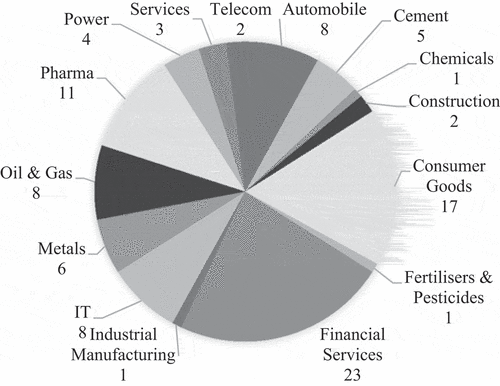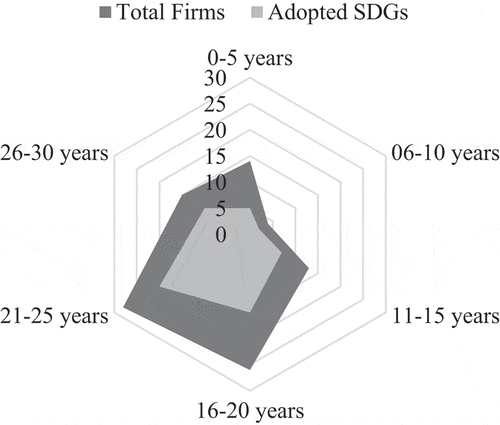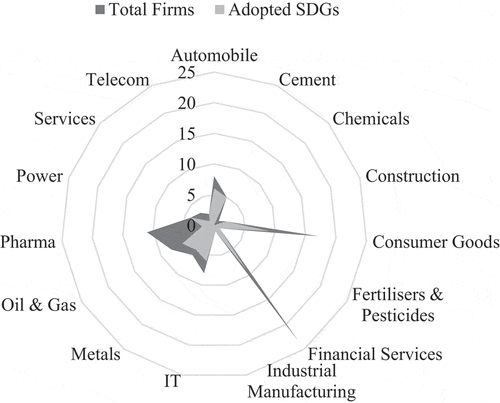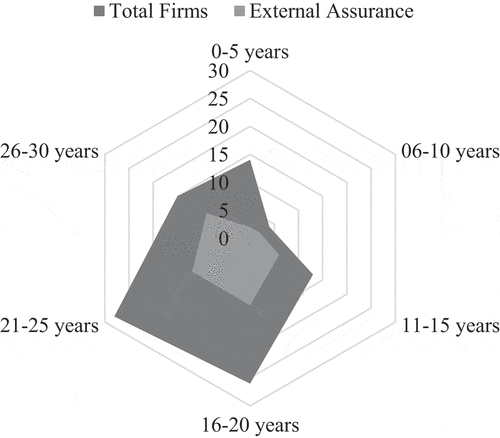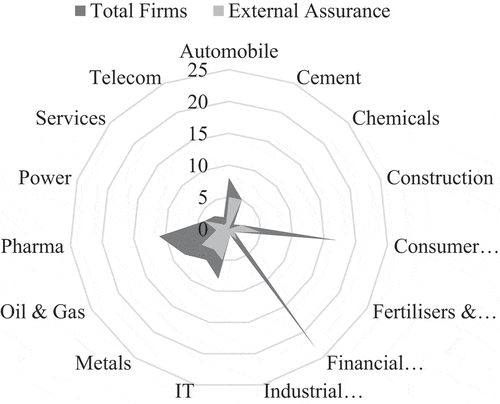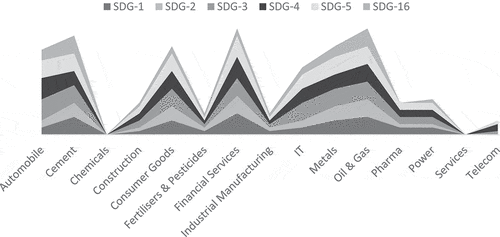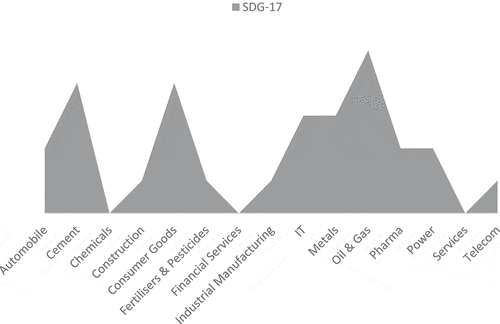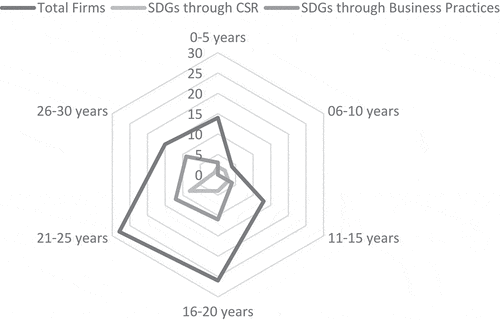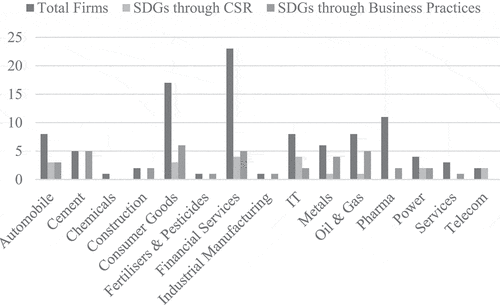Abstract
The United Nations Sustainable Development Goals (SDGs) are a basket of major global challenges. No business is untouched by the challenges presented by the SDGs. The SDGs are well connected with the three pillars of corporate sustainability. This research paper has two unique properties: first, it uses a stakeholder approach to establish the organic linkages between the triple bottom line (TBL) approach and SDGs. India is committed to the SDGs of the United Nations. Indian public and private corporations can play a key role in India’s commitments to achieving SDGs by 2030. The second objective of this study is to examine the alignment of the top 100 Indian companies with the SDGs based on quantitative content analysis. The proposed SDG-TBL framework contributes to advance theoretical and practical understanding of the factors influencing the adoption of SDGs by businesses. This article also offers implications for researchers and practitioners.
PUBLIC INTEREST STATEMENT
Global goals represent our shared vision to make the world a better place by 2030. Businesses have the resources to support the timely achievement of the SDGs. The proposed TBL-SDGs framework validates that TBL is organically aligned with Agenda 2030, urging corporations to participate positively in the sustainable development of the world. SDG integration by businesses is contingent on their listing age and industry segment. It was found that there are several SDGs on which businesses have focused inadequately. Policymakers, regulators, and the government need to formulate policies to stimulate businesses to participate in all SDGs. From a corporate perspective, embedding SDGs into key business processes has long-term commercial value by finding new growth opportunities and reducing the risk associated with their profiles.
1. Introduction
Contemporary businesses operate in a “multi-stakeholder ecosystem paradigm,” where the vital resources necessary for organizations’ long-term survival are dependent on the stakeholder world (Desai, Citation2018; Viglia et al., Citation2018). From the sustainable development perspective, firms need to engage with their various stakeholders (Amaeshi & Crane, Citation2006). However, corporations often struggle to build a sustainable relationship with multiple stakeholders (Maak, Citation2007). As a result of this complex situation, corporations confront multiple integrally entangled sustainability challenges, and such a hostile environment stimulates firms to embrace an adaptive approach (Hörisch et al., Citation2014).
In the management literature, social and environmental expectations of stakeholders from businesses have nurtured the concept of sustainability (Cennamo et al., Citation2012; Herremans et al., Citation2016; Lim & Greenwood, Citation2017). As stated by Elkington (Citation1999), Corporate sustainability is the archetype for 21st-century businesses. The emergence of the sustainability concept has urged businesses to re-examine their approach to measuring their performance. Businesses must work for complete system stability to ensure their viability in complex mutual stakeholder systems (Sulkowski et al., Citation2018). In recent years, the expectations of stakeholders from businesses have increased extensively. Business maneuvers occur within the social and environmental periphery, so social and environmental aspects need to be considered. (Anbarasan & Sushil, Citation2018; Johnson et al., Citation2018; Kepore & Imbun, Citation2011). McLaren (Citation2004) claimed that stakeholders measure firms’ success with their societal and environmental performances.
Elkington (Citation1998) explained that sustainability is dependent on three interconnected dimensions, namely economic prosperity, social equity, and environmental integrity. Businesses should consider all three approaches with equal importance (Venkatraman & Nayak, Citation2015). This perspective has marked a paradigm shift and urges businesses to shift their focus from the traditional bottom-line approach to the triple bottom line (TBL) approach (Hardjono & van Marrewijk, Citation2001). The relationship between Economic, Social, and Environmental facets of business sustainability is termed TBL (Svensson et al., Citation2018).
1.1. Stakeholder definition from the corporate sustainability perspective
A stakeholder is a social construct of different entities having the potential to influence or get affected by the businesses (Jakhar, Citation2017); it is “a generic term and includes both individuals and groups” (Greco et al., Citation2015). Based on the relational perspective, Sulkowski et al. (Citation2018) has identified stakeholders as the key elements of any business. According to Noland and Phillips (Citation2010), stakeholders are the building blocks of an organization, and the businesses operate in a space created by a network of stakeholders.
The stakeholder definition suggested by Freeman (Citation1984), “any group or individual who can affect or is affected by the achievement of the organization’s objectives,” has been the most influential in management literature for the last three decades. Researchers have extended the human-oriented definition of stakeholder to include various “non-human actors” who can disturb or are upset by companies’ actions (Missonier & Loufrani-Fedida, Citation2014). Society and the environment have “value and implications” for companies and are therefore indispensable to businesses (Anbarasan & Sushil, Citation2018; Lane & Devin, Citation2018). The firm is also a stakeholder on the socio-ecological system, with society and the environment as the autochthonous stakeholder (Henriksson & Weidman Grunewald, Citation2020; Sulkowski et al., Citation2018).
1.2. Sustainable development goals
In 2000, world leaders committed themselves to the United Nations Millennium Development Goals (MDGs)—a development plan with a specified deadline of 2015. After fifteen years, even though substantial growth was recorded globally, many countries failed to meet the MDGs targets (Battersby, Citation2017; Satterthwaite, Citation2016). In 2015, MDGs ended their term and replaced the Sustainable Development Goals (SDGs) to address the unfinished agenda (Kumar et al., Citation2016). The 17 SDGs have been moulded from MDGs with the addition of other global problems such as climate change, economic inequality, innovation, sustainable consumption, peace and justice. In September 2015, 193 member states of the United Nations adopted SDGs to shape the world’s most ambitious agenda. The SDG framework has 17 goals with 169 targets related to poverty, food, health, education, women, water, energy, economy, infrastructure, inequality, habitation, consumption, climate, marine ecosystems, institutions for peace, and sustainable development (Carreira et al., Citation2017). It is an ambitious plan to make the world more inclusive and sustainable by the year 2030 (Borges et al., Citation2017). SDGs are comprehensive and applicable to all nations, therefore also known as Global Goals. The SDGs’ prime objective is to restructure the development model globally (Pradhan et al., Citation2017).
The SDGs have a 2030 deadline and require fast-track actions (Nhamo & Mjimba, Citation2020). Creative and innovative solutions are needed to tackle the challenges posed by SDGs. Businesses have the resources and capabilities to stimulate SDGs through innovation, research, technology, funding, and employment. However, businesses seek greater motivation to engage with SDGs, particularly beyond statutory CSR spending (Scheyvens et al., Citation2016).
Analogous to TBL, the UN SDG framework was also designed with a stakeholder perspective. The goals are clear and time-bound and demand active participation from all stakeholders (Anderson & Ratiu, Citation2019). SDGs are the most comprehensive framework for inclusive growth (Borges et al., Citation2017). No business can succeed if society fails, and businesses need to understand that SDGs provide an opportunity for businesses and societies to live and prosper together (Pedersen, Citation2018).
1.3. Connecting corporate sustainability to sustainable development goals
The role of businesses can be redefined with the fact that sustainable development of the world and the future of the upcoming generations depend on the companies’ current choices and actions (Morioka et al., Citation2017). Corporate sustainability is a concept that drives organizations to improve their performance in all three dimensions of TBL, and SDGs have clear and time-bound targets. Establishing linkages between the three pillars of the TBL concept and 17 SDGs can be insightful for businesses. A TBL-SDG framework can inspire businesses to participate actively and contribute to the SDGs. Integration of TBL and SDGs can provide businesses with all the internal and external motivation to contribute to the world’s sustainable development. With the TBL-SDG framework, the main aim of this study is to systematically integrate the secluded social and environmental dimensions of corporate sustainability into business.
From the corporate sustainability perspective, firm, society, and environment are the three key stakeholders associated with creating economic, social, and environmental values, respectively (Anbarasan & Sushil, Citation2018). In developing the TBL-SDG framework, these three stakeholders are positioned at the core to establish the linkages between TBL and SDGs. The three pillars of corporate sustainability are interrelated (Purvis et al., Citation2019). Similarly, global goals are highly connected and form a complex interlinkage network (Swain & Ranganathan, Citation2021; Tosun & Leininger, Citation2017). Consistent with Fonseca and Carvalho (Citation2019), this study considered all SDGs in seclusion and used a systematic approach to develop the TBL-SDGs framework.
1.3.1. Society and SDGs
Social sustainability refers to the company’s ability to ensure the wellbeing of society. Businesses often fail to understand the social dimension of the TBL framework. Firms undertake various projects for the community in their corporate social responsibility (CSR) programs. However, these CSR initiatives fail to establish the impact of firms’ activities on society and determine accountability. From the community standpoint, corporations consider adopting sustainability beyond the CSR activities to be discretionary rather than necessary (Padin et al., Citation2016).
Poverty, hunger, health, education, gender discrimination, water and sanitation, employment, inequality, peace, and justice are the issues that directly affect society. The nine SDGs that can be classified in the social dimension of the TBL approach are
SDG 1: No Poverty—End poverty in all its forms everywhere.
SDG 2: Zero Hunger—End hunger, achieve food security and improved nutrition and promote sustainable agriculture.
SDG 3: Good Health and Wellbeing—Ensure healthy lives and promote the wellbeing of all ages.
SDG 4: Quality Education—Ensure inclusive and equitable quality education and promote lifelong learning opportunities for all.
SDG 5: Gender Quality—Achieve gender equality and empower all women and girls.
SDG 6: Clean Water and Sanitation—Ensure availability and sustainable management of water and sanitation for all.
SDG 8: Decent Work and Economic Growth—Promote sustained, inclusive and sustainable economic growth, full and productive employment and decent work for all.
SDG 10: Reduce Inequalities—Reduce inequality within and among countries.
SDG 11: Sustainable Cities and Communities—Make cities and human settlements inclusive, safe, resilient and sustainable.
SDG 12: Responsible Consumption and Production—Ensure sustainable consumption and production patterns.
SDG 16: Peace and Justice—Promote peaceful and inclusive societies for sustainable development, provide access to justice for all and build effective, accountable and inclusive institutions at all levels.
Businesses pursuing the above SDGs can enhance their contribution to the community perspective of the TBL approach to corporate sustainability.
1.3.2. Environment and SDGs
Environmental sustainability refers to the firm’s ability to conserve and preserve the natural environment. Companies often envision Cost-cutting measures as the primary tool to engage in environmental conservation activities. Several organizations have adopted environmental management systems (EMS) (Knowles et al., Citation1999). Undoubtedly, EMS is an effective way to measure a firm’s performance from an environmental perspective (Vanclay, Citation2010). However, a holistic approach is necessary to better understand the TBL concept’s environmental perspective (Sridhar & Jones, Citation2013).
From an environmental perspective, clean water, clean energy, sustainable cities, climate change, and sustainable marine and land resources are major challenges. The six SDGs that can be categorized in the environmental dimension of the TBL approach are:
SDG 6: Clean Water and Sanitation—Ensure availability and sustainable management of water and sanitation for all.
SDG 7: Affordable and Clean Energy—Ensure access to affordable, reliable, sustainable and modern energy for all.
SDG 11: Sustainable Cities and Communities—Make cities and human settlements inclusive, safe, resilient and sustainable.
SDG 13: Climate Action—Take urgent action to combat climate change and its impacts.
SDG 14: Life below Water—Conserve and sustainable use the oceans, seas and marine resources for sustainable development.
SDG 15: Life on Land—Protect, restore and promote sustainable use of terrestrial ecosystems, sustainably manage forests, combat desertification, and halt and reverse land degradation and halt biodiversity loss.
By acting for SDG 6, SDG 7 and SDG 13 to SDG 15, businesses can create ecological value and contribute to the environmental perspective of the TBL approach to corporate sustainability.
1.3.3. Firm and SDGs
Economic sustainability refers to the company’s ability to survive, make profits and contribute to the economy (Roberts & Tribe, Citation2008). Gender discrimination, decent work and economic growth of employees, inequality at the workplace, clean energy, innovation, and sustainable use of resources are vital challenges for businesses. The six goals that are associated with the economic perspective of the TBL approach are:
SDG 5: Gender Quality—Achieve gender equality and empower all women and girls.
SDG 7: Affordable and Clean Energy—Ensure access to affordable, reliable, sustainable and modern energy for all.
SDG 8: Decent Work and Economic Growth—Promote sustained, inclusive and sustainable economic growth, full and productive employment and decent work for all.
SDG 9: Industry, Innovation and Infrastructure—Build resilient infrastructure, promote inclusive and sustainable industrialisation and foster innovation.
SDG 10: Reduce Inequalities—Reduce inequality within and among countries.
SDG 12: Responsible Consumption and Production—Ensure sustainable consumption and production patterns.
Businesses can enhance their economic dimension of the TBL approach by working for SDG 8 to SDG 12.
1.3.4. SDG-17 and sustainability of TBL elements
Global goals are ambitious and need extraordinary support from all stakeholders, including businesses (Anderson & Ratiu, Citation2019). Cooperation between stakeholders is necessary to meet all the 16 SDGs directly linked with three dimensions (economic, social, and environmental) of TBL.
SDG 17: Partnerships for the Goals—Strengthen the means of implementation and revitalise the global partnership for sustainable development.
SDG17 provides businesses with the opportunity to lead a shared value creation process and enhance their long-term sustainability (Pedersen, Citation2018).
The proposed TBL-SDG framework is shown in . This holistic framework is based on the organic linkages and explains the 16 SDGs to businesses using the TBL concept. Also, the proposed framework calls for collaboration among all stakeholders for sustainable value creation along all three dimensions of the TBL approach.
Figure 1. TBL-SDGs framework (adapted from Fonseca & Carvalho, Citation2019)
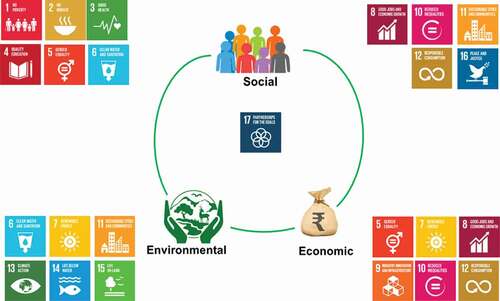
1.4. India and SDGs
India is one of the fastest-growing economies in the world (Sankaran et al., Citation2020). On the other hand, India has been facing many social, economic, and environmental challenges such as low per capita income, poverty, hunger, energy security, water security, large population, sanitation, poor health care, depleting natural resources, climate change (Bansal et al., Citation2020). India has played a vital role in shaping the UN SDGs of the United Nations and supported the 2030 agenda for sustainable development (Aayog, Citation2017). India has pledged to the effective implementation of SDGs. As per MoSPI (Citation2015), India missed the national targets of the MDGs, and SDGs are significant and crucial from the Indian context. Meeting the SDGs targets by 2030 will be essential for India and its growth journey.
United Nations estimates that SDGs require an investment of USD 90 trillion, with India needing USD 2.5 trillion to achieve its climate change targets by 2030 (UNFCCC (United Nations Framework Convention on Climate Change), Citation2015). This considerable investment seeks the active participation of businesses to turn sustainable development challenges into opportunities and play a key role in meeting SDGs targets (Ghosh & Rajan, Citation2019; Mio et al., Citation2020; Scheyvens et al., Citation2016). Compared to MDGs, businesses worldwide are more sensitive and engaged with SDGs through initiatives such as the UN Global Compact. Indian businesses have gradually adopted practices to achieve the SDGs (Mishra, Citation2021; Poddar et al., Citation2019). The achievement of SDGs depends on the speed with which companies develop more innovative and inclusive business models (Scheyvens et al., Citation2016). This paper’s key objective is to examine the orientation of the top 100 Indian companies with SDGs based on quantitative content analysis. The two research questions prepared to fit the primary purpose of this study are:
Research question 1: Based on quantitative content analysis, does the adoption of SDGs by the top 100 Indian companies is dependent on their listing age.
Research question 2: Based on quantitative content analysis, does the adoption of SDGs by the top 100 Indian companies is dependent on their industry segment.
The following section explains the research method. Sections 3 and 4 present the research paper findings and further discussion. The final section of this study offers the conclusions, implications, and limitations, followed by suggestions for future inquiries.
2. Research methodology
Content analysis is a systematic research method used to analyze the documents and gather data to test the theoretical problems. It allows researchers to draw replicable and logical conclusions from the data (Krippendorff, Citation2018). Studies focusing on non-financial information of corporate reporting uses content analysis as a research method to capture data on social and environmental disclosures (Guthrie & Abeysekera, Citation2006). Non-financial disclosures are primarily qualitative, and content analysis allows to capture and analysis of diverse empirical data. (Guthrie et al., Citation2004).
This study used inductive content analysis to examine the top 100 Indian companies’ alignment with the SDGs. There are three main phases in content analysis-preparation, organizing, and reporting (Elo & Kyngäs, Citation2008).
2.1. Preparation phase
We downloaded the list of the top 100 Indian companies based on market capitalization from the website of the National Stock Exchange of India Limited (a leading stock exchange in India), along with other relevant information such as industry category and listing date. The top 100 Indian companies are classified into 15 industry groups by the National Stock Exchange of India Limited, as shown in . The listing date of the firms on the stock exchange was used to calculate the listing age.
2.1.1. Selection of non-financial disclosure reports
The disclosure content of annual reports provided by corporations is an area of considerable interest to organizational researchers (Guthrie et al., Citation2004). Corporate disclosures are labeled as mandatory (such as financial reports, business responsibility report) or voluntary (such as sustainability report, corporate sustainability report, ESG report) (Rowe et al., Citation2014). An organization can use either or both types of disclosures or an integrated mode (such as integrated reports) to communicate with its stakeholders (Garrido‐Miralles et al., Citation2016). Annual reports are deemed as the most appropriate abode for all kinds of disclosures. Disclosure reports enable stakeholders to measure businesses’ social and environmental impact (Othman & Ameer, Citation2010). Stakeholders perceive selected disclosure by firms as an eyewash (Blackburn et al., Citation2018; Martín‐de Castro et al., Citation2016). Multiple disclosures in discrete or integrated style comprising financial, social, and environmental aspects, based on the stakeholders’ needs, are suggested for an effective stakeholder engagement (Prado‐Lorenzo et al., Citation2009). Over the years, business disclosure has increased considering the stakeholders’ needs (Sierra‐García et al., Citation2015).
Based on this study’s objective to investigate the alignment of Indian companies with the SDGs, it was decided to include both mandatory and voluntary reports in the content analysis. Corporate reports were downloaded in PDFs from companies’ websites in six categories: Annual Report, Integrated Report, Sustainability Report, Business Responsibility Report, ESG Report, and Corporate Social Responsibility Report. The downloaded PDF files of corporate reports were converted into readable text documents
2.1.2. Selection of keywords and their codification for content analysis
For systematic content analysis of the documents to provide evidence-based conclusions to research questions, the texts were categorized into two keywords groups: UN SDGs and the Assurance of Non-Financial Disclosure.
2.2. Organizing phase
2.2.1. Pilot run
The two scholars independently conducted a pilot run on five firms to test the coding scheme before the final content analysis. Test run allowed to distinguish between reporting on SDGs action and SDGs performance based on the type of measurement and time orientation presented in . Test run also allowed to refine and finalize data collection points (DCPs) and codify them for data capturing during content analysis. The finalized texts, data collection points, and codes are shown in .
Table 1. Criteria and data collection points
Table 2. Finalized texts, data collection point, and code
2.2.2. Text analysis
An in-depth manual content analysis of the corporate disclosure documents was adopted for the two keywords groups. Coded data were captured and recorded from the corporate reports for all the DCPs. Company-wise recorded data across all DCPs is made available in Annexure-1.
2.3. Reporting phase
The collected qualitative data was plotted, analyzed, and correlated the variables using the Chart tool available in Microsoft Excel. The findings of the content analysis are presented in the next section of this article.
3. Results
Among the top 100 Indian companies based on market capitalization, the firms’ listing age ranged from zero to 30 years. The investigation revealed that the SDG adoption is contingent on the firms’ listing age, as shown in . Of the 69 corporations above the listing age of 15 years, 45 firms have adopted the SDGs. However, out of 31 companies up to 15 years of listing age, only 14 firms have adopted SDGs.
The industry-wise result on the adoption of SDGs is shown in . The analysis uncovered that firms in cement, construction, fertilizers & pesticides, industrial manufacturing, power, and telecom segments had adopted SDGs. In companies related to chemicals, financial services, pharma, and services industries, less than 50 percent of the firms have adopted SDGs.
Investigation on the external assurance by the top 100 Indian corporations revealed that the independent assurance of non-financial disclosure is dependent on the company’s listing age, as shown in . Of the 69 corporations above the age of 15 years, 33 have externally assured non-financial disclosure in their corporate reports. However, only 10 out of 31 firms up to the listing age of 15 have independently assured their non-financial disclosures.
The outcomes on the relationship between external assurance of non-financial disclosure and industry are shown in . Firms in cement, construction, fertilizers and pesticides, industrial manufacturing, and power industries have independently assured their non-financial disclosures. However, less than 50 percent of companies in the chemicals, consumer goods, financial services, pharma, and service sectors have externally assured their non-financial disclosures.
The outcomes of the industry-wise analysis of SDGs related to the social aspect of TBL are shown in . It was found that firms working in industries such as oil and gas, financial services, cement, consumer goods are more involved in SDGs linked to the social aspect of TBL than companies dealing in chemicals, fertilizers, industrial manufacturing, services, pharma, power, and telecom sectors.
For the SDGs related to the environmental dimension of TBL, the findings are primarily similar to the SDGs related to the social dimension of TBL. It found that companies operating in the metals and power industries to be slightly more concerned with their environmental impact than the social aspect. The results of the industry’s preference for environmental SDGs are shown in .
present the industry-wise priority for the SDGs related to the economic dimension of TBL. It found similarities in the overall pattern of the economic dimension with the social and environmental dimensions. In the case of SDGs related to the economic aspects of TBL, automobile companies are more involved, followed by firms operating in the oil and gas, financial services, and cement industries.
The pattern for the adoption of SDG-17 in industries is shown in . Investigations suggested that oil and gas firms are more active in engagement with other stakeholders to meet the 16 SDGs. Financial services firms leading the adoption of the SDGs related to all three TBL dimensions are utterly inactive with SDG-17.
Findings on the integration of SDGs revealed that newly listed firms engage in SDGs with CSR practices, while companies over 15 years of age integrate SDGs into all business practices such as operations, strategy, value chain, and CSR. presents the outcomes on the association of SDG integration with firms listing age.
Industry-wise analysis of SDGs integration retrieved that all firms involved in cement, construction, fertilizers and pesticides, industrial manufacturing industries have adopted SDGs through business practices. Metals, oil and gas, consumer goods, financial services, and pharma companies have more entrusted business practices to adopt the SDGs. Telecom companies have entirely relied on the CSR approach to SDR, and IT corporations have also preferred CSR way to SDGs. Firms related to the automobile and electric industries are equally divided between the two approaches to adopt the SDGs. The outcome of SDGs integration across industries is shown in .
Out of the top 100 Indian companies, 59 companies have adopted SDGs, and the findings on their SDG measurement and time orientation are presented in . 49 firms have mapped the SDGs with their business activities ranging from strategy to operations and corporate governance to CSR. Thirty-four companies are measuring their SDGs annual performance and benchmarking it with the achievements of previous years. In terms of time orientation, 13 firms have set future short-term targets for the SDGs. Seven companies have designed their self-plan aligned with global goals 2030, such as ACC’s Sustainability Development 2030 Plan, Ambuja Cements’ Sustainable Development Ambition 2030, Adani Green Energy’2030 Targets, DLF’s 2030 SDG Targets, Hero MotoCorp’s 2030 Targets, Hindustan Unilever’s 2030 Targets, ITC’s Organizational Goals 2030 and Larsen & Toubro Infotech’s Sustainability Roadmap 2030,
Table 3. SDGs measurement & time orientation
4. Discussion
In this section, findings in relation to previous studies on the adoption of SDGs and organizational factors are discussed. In particular, the adoption of SDGs, external assurance of non-financial disclosure information, and SDGs integration with SDGs concerning the firm’s listing age and its industry segment are discussed.
Rosati and Faria (Citation2019) argued that firms committed to voluntary reporting are more likely to adopt SDGs, and Prencipe (Citation2004) found that businesses’ voluntary disclosure is positively associated with their listing age. The investigation discovered that SDG adoption and the firm’s listing age are positively related based on the corporate disclosures. Consistent with García‐Sánchez et al. (Citation2019) on sustainability reporting across industries, this study also found differences in the adoption of SDGs between industry sectors.
García‐Sánchez et al. (Citation2019) claimed that businesses assuring their sustainability reports independently are more likely to adopt the SDGs. A positive relationship between company listing age and independent assurance of non-financial disclosure was found. The investigation also noted differences in the external assurance of voluntary reporting between industry sectors. The TBL-SDG framework was used to examine each SDG’s adoption by the top 100 Indian companies, and the results revealed that each industry segment had different priorities. The study also suggests that SDG integration by a firm is dependent on its listing age. Young firms prefer to integrate SDGs based on CSR practices, while older firms adopt a holistic view of SDG integration based on business activities, including CSR. The study also showed that SDG integration practices differ by industry sector.
To provide a holistic view on the adoption of SDGs by businesses, each SDG’s adoption by the top 100 Indian companies was analyzed. SDG-8 (Decent work and economic growth) has been given greater emphasis by corporations, followed by SDG-3 (Good health and wellbeing), SDG-4 (Quality education), and SDG-5 (Gender equality). While SDG-14 (Life below water) has attracted the attention of very few firms, followed by SDG-16 (Peace, Justice and Strong Institutions) and SDG-17 (Partnership for the Goals).
As Mukhi and Quental (Citation2019) stated, all SDGs are equal and essential, but some SDGs are vital for every firm, such as SDG 17—an imperative for the success of other SDGs adopted by the company. The trend of SDG adoption of the top 100 Indian companies reveals that 15 firms have adopted all 17 SDGs, 26 enterprises have accepted 11 to 15 SDGs, seven corporations have embraced 6–10 SDGs, and three businesses have implemented 1 to 5 SDGs. A firm may not find all SDGs equally essential and relevant. However, the TBL-SDG framework can easily enable businesses to link and associate with the maximum number of SDGs.
5. Conclusion, implications, and limitations
Adoption of SDGs, external assurance of non-financial disclosure, and SDG integration by businesses are contingent on their listing age and industry segment. 17 SDGs are universal, interrelated, and integrated (Delgado-Ceballos et al., Citation2020), and the secluded view for the SDGs has been used in this study to establish the relationship between the SDGs and the TBL framework. The proposed TBL-SDG framework validates that TBL is organically aligned with SDGs, urging corporations to positively participate in the stakeholder world’s sustainable development.
5.1. Implication for practitioners
Corporate sustainability is a function of social, environmental, and economic sustainability. From the sustainability point of view, businesses have started to find a relationship with the TBL concept. However, many organizations have found TBL an unsettling concept calling for broader firm responsibilities beyond transactional relationships. TBL is seen as too complex, confronting managers with multilateral and interrelated social, environmental and economic aspects (Hahn et al., Citation2010). With the proposed TBL-SDG framework, businesses can define, measure and benchmark their goals in three TBL dimensions. In the proposed TBL-SDG framework, the TBL concept can steer the decision-making processes, and SDGs can shape the businesses’ targets.
In addition to the TBL perspective, the United Nations SDGs agenda offers many critical viewpoints and can encourage businesses to engage with global goals. 193 countries are committed to the SDGs and are developing national-level programs and policies to achieve the goals. Government and citizens are two important stakeholder groups, which significantly affect businesses’ performance in a country. These two stakeholder groups will favor companies that align their core business processes with their priorities, not corporations that do not engage with the country’s interests. Moreover, the voluntary support by the government and citizens of a country can create a competitive advantage for some businesses. Williams (Citation2015) stated that embedding SDGs into key business processes has a long-term commercial significance. Businesses should align their key processes with the SDGs to find new growth opportunities and reduce the risk associated with their profiles.
This study found that there are many SDGs on which businesses have focused less. Policymakers, regulators, and the government should formulate policies to motivate businesses to participate in overlooked SDGs.
5.2. Limitations and implications for researchers
Irrespective of the in-depth analysis, key findings, and important conclusions, this study has its limitations. The content analysis approach assisted in understanding the organizational factors influencing SDG adoption. From the TBL-SDG framework, SDG adoption is a complex phenomenon and can further enhance quantitative study understanding. This study focused on the top 100 Indian companies to conclude, and this is an explicit limitation. The inclusion of the top 500 Indian companies may give more generalized conclusions. In this research, secondary data from published reports of corporations have been used. From the sustainability perspective, SDGs are strategic, and therefore, multiple case studies based on primary data can be valuable. In future exploration, researchers should perform a similar study in the same industry segment, and different countries can lead to a better understanding of SDGs adoption.
Disclosure statement
The author(s) declare that there is no conflict of interest.
Additional information
Funding
Notes on contributors
Avinash Pratap Singh
Avinash Pratap Singh is a Research Scholar in the Department of Management Studies at the Indian Institute of Technology Roorkee, India. He has more than nine years of work experience in the Energy and Industry sectors. His areas of interest are corporate strategy, corporate governance, stakeholder approach, SDGs, and sustainable businesses.

Zillur Rahman
Zillur Rahman is a renowned academician in the field of Marketing and Strategy. Currently, he is working as a Professor in the Department of Management Studies, at IIT Roorkee, India. His work has been published and cited in various international journals like Management Decision, Managing Service Quality, International Journal of Information Management, Social Responsibility Journal, European Business Review, International Journal of Emerging Markets, Journal of Business and Industrial Marketing. He has also authored several books like Marketing Research, Strategic Market Management, Operations Management and Systems Engineering etc.
References
- Aayog, N. I. T. I. (2017). Voluntary national review report on implementation of sustainable development goals. United Nations high level political forum. Available at: https://niti.gov.in/writereaddata/files/India%20VNR_Final.pdf (accessed on 2021, March 02).
- Amaeshi, K. M., & Crane, A. (2006). Stakeholder engagement: A mechanism for sustainable aviation. Corporate Social Responsibility and Environmental Management, 13(5), 245–19. https://doi.org/https://doi.org/10.1002/csr.108
- Anbarasan, P., & Sushil. (2018). Stakeholder engagement in sustainable enterprise: Evolving a conceptual framework and a case study of ITC. Business Strategy and the Environment, 27(3), 282–299. https://doi.org/https://doi.org/10.1002/bse.1999
- Anderson, B. B., & Ratiu, C. (2019). Stakeholder considerations in public-private partnerships. World Journal of Entrepreneurship, Management and Sustainable Development, 15(3), 212–221. https://doi.org/https://doi.org/10.1108/wjemsd-04-2018-0046
- Bansal, S., Garg, I., & Yadav, A. (2020). Can social entrepreneurship help attain sustainable development goals: A study of India. World Review of Entrepreneurship, Management and Sustainable Development, 16(2), 172–186. https://doi.org/https://doi.org/10.1504/wremsd.2020.10027692
- Battersby, J. (2017). MDGs to SDGs–new goals, same gaps: The continued absence of urban food security in the post-2015 global development agenda. African Geographical Review, 36(1), 115–129. https://doi.org/https://doi.org/10.1080/19376812.2016.1208769
- Blackburn, N., Hooper, V., Abratt, R., & Brown, J. (2018). Stakeholder engagement in corporate reporting: Towards building a strong reputation. Marketing Intelligence and Planning, 36(4), 484–497. https://doi.org/https://doi.org/10.1108/mip-10-2017-0236
- Borges, J. C., Ferreira, T. C., de Oliveira, M. S. B., Macini, N., & Caldana, A. C. F. (2017). Hidden curriculum in student organizations: Learning, practice, socialization and responsible management in a business school. The International Journal of Management Education, 15(2), 153–161. https://doi.org/https://doi.org/10.1016/j.ijme.2017.03.003
- Carreira, F., Aguiar, A. C., Onça, F., & Monzoni, M. (2017). The celsius game: An experiential activity on management education simulating the complex challenges for the two-degree climate change target. The International Journal of Management Education, 15(2), 350–361. https://doi.org/https://doi.org/10.1016/j.ijme.2017.03.012
- Cennamo, C., Berrone, P., Cruz, C., & Gomez–Mejia, L. R. (2012). Socioemotional wealth and proactive stakeholder engagement: Why family–controlled firms care more about their stakeholders. Entrepreneurship Theory and Practice, 36(6), 1153–1173. https://doi.org/https://doi.org/10.1111/j.1540-6520.2012.00543.x
- Delgado-Ceballos, J., Ortiz-de-Mandojana, N., Antolin-Lopez, R., & Montiel, M. (2020). Our house is on fire! The role of business in achieving the 2030 United Nations sustainable development goal. Business Research Quarterly.
- Desai, V. M. (2018). Collaborative stakeholder engagement: An integration between theories of organizational legitimacy and learning. Academy of Management Journal, 61(1), 220–244. https://doi.org/https://doi.org/10.5465/amj.2016.0315
- Elkington, J. (1998). Partnerships from cannibals with forks: The triple bottom line of 21st‐century business. Environmental Quality Management, 8(1), 37–51. https://doi.org/https://doi.org/10.1002/tqem.3310080106
- Elkington, J. (1999). Triple bottom line revolution: Reporting for the third millennium. Australian CPA, 69(11), 75–76.
- Elo, S., & Kyngäs, H. (2008). The qualitative content analysis process. Journal of Advanced Nursing, 62(1), 107–115. https://doi.org/https://doi.org/10.1111/j.1365-2648.2007.04569.x
- Fonseca, L., & Carvalho, F. (2019). The reporting of SDGs by quality, environmental, and occupational health and safety-certified organizations. Sustainability, 11(20), 5797. https://doi.org/https://doi.org/10.3390/su11205797
- Freeman, R. E. (1984). Strategic management: A stakeholder approach. Pitman.
- García‐Sánchez, I. M., Hussain, N., Martínez‐Ferrero, J., & Ruiz‐Barbadillo, E. (2019). Impact of disclosure and assurance quality of corporate sustainability reports on access to finance. Corporate Social Responsibility and Environmental Management, 26(4), 832–848. https://doi.org/https://doi.org/10.1002/csr.1724
- Garrido‐Miralles, P., Zorio‐Grima, A., & García‐Benau, M. A. (2016). Sustainable development, stakeholder engagement and analyst forecasts’ accuracy: Positive evidence from the Spanish setting. Sustainable Development, 24(2), 77–88. https://doi.org/https://doi.org/10.1002/sd.1607
- Ghosh, S., & Rajan, J. (2019). The business case for SDGs: An analysis of inclusive business models in emerging economies. International Journal of Sustainable Development & World Ecology, 26(4), 344–353. https://doi.org/https://doi.org/10.1080/13504509.2019.1591539
- Greco, G., Sciulli, N., & D’Onza, G. (2015). The influence of stakeholder engagement on sustainability reporting: Evidence from Italian local councils. Public Management Review, 17(4), 465–488. https://doi.org/https://doi.org/10.1080/14719037.2013.798024
- Guthrie, J., & Abeysekera, I. (2006). Content analysis of social, environmental reporting: What is new? Journal of Human Resource Costing & Accounting, 10(2), 114–126. https://doi.org/https://doi.org/10.1108/14013380610703120
- Guthrie, J., Petty, R., Yongvanich, K., & Ricceri, F. (2004). Using content analysis as a research method to inquire into intellectual capital reporting. Journal of Intellectual Capital, 5(2), 282–293. https://doi.org/https://doi.org/10.1108/14691930410533704
- Hahn, T., Figge, F., Pinkse, J., & Preuss, L. (2010). Trade‐offs in corporate sustainability: You can’t have your cake and eat it. Business Strategy and the Environment, 19(4), 217–229. https://doi.org/https://doi.org/10.1002/bse.674
- Hardjono, T. W., & van Marrewijk, M. (2001). The social dimensions of business excellence. Corporate Environmental Strategy, 8(3), 223–233. https://doi.org/https://doi.org/10.1016/s1066-7938(01)00125-7
- Henriksson, H., & Weidman Grunewald, E. (2020). Society as a stakeholder. In Sustainability leadership. Palgrave Macmillan. https://doi.org/https://doi.org/10.1007/978-3-030-42291-2_10
- Herremans, I. M., Nazari, J. A., & Mahmoudian, F. (2016). Stakeholder relationships, engagement, and sustainability reporting. Journal of Business Ethics, 138(3), 417–435. https://doi.org/https://doi.org/10.1007/s10551-015-2634-0
- Hörisch, J., Freeman, R. E., & Schaltegger, S. (2014). Applying stakeholder theory in sustainability management: Links, similarities, dissimilarities, and a conceptual framework. Organization & Environment, 27(4), 328–346. https://doi.org/https://doi.org/10.1177/1086026614535786
- Jakhar, S. K. (2017). Stakeholder engagement and environmental practice adoption: The mediating role of process management practices. Sustainable Development, 25(1), 92–110. https://doi.org/https://doi.org/10.1002/sd.1644
- Johnson, M., Redlbacher, F., & Schaltegger, S. (2018). Stakeholder engagement for corporate sustainability: A comparative analysis of B2C and B2B companies. Corporate Social Responsibility and Environmental Management, 25(4), 659–673. https://doi.org/https://doi.org/10.1002/csr.1484
- Kepore, K. P., & Imbun, B. Y. (2011). Mining and stakeholder engagement discourse in a Papua New Guinea mine. Corporate Social Responsibility and Environmental Management, 18(4), 220–233. https://doi.org/https://doi.org/10.1002/csr.243
- Knowles, T., Macmillan, S., Palmer, J., Grabowski, P., & Hashimoto, A. (1999). The development of environmental initiatives in tourism: Responses from the London hotel sector. International Journal of Tourism Research, 1(4), 255–265. https://doi.org/https://doi.org/10.1002/(sici)1522-1970(199907/08)1:4%3C255::aid-jtr170%3E3.0.co;2-8
- Krippendorff, K. (2018). Content analysis: An introduction to its methodology. Sage publications.
- Kumar, S., Kumar, N., & Vivekadhish, S. (2016). Millennium development goals (MDGS) to sustainable development goals (SDGS): Addressing unfinished agenda and strengthening sustainable development and partnership. Indian Journal of Community Medicine, 41(1), 1–4. https://doi.org/https://doi.org/10.4103/0970-0218.170955
- Lane, A. B., & Devin, B. (2018). Operationalizing stakeholder engagement in CSR: A process approach. Corporate Social Responsibility and Environmental Management, 25(3), 267–280. https://doi.org/https://doi.org/10.1002/csr.1460
- Lim, J. S., & Greenwood, C. A. (2017). Communicating corporate social responsibility (CSR): Stakeholder responsiveness and engagement strategy to achieve CSR goals. Public Relations Review, 43(4), 768–776. https://doi.org/https://doi.org/10.1016/j.pubrev.2017.06.007
- Maak, T. (2007). Responsible leadership, stakeholder engagement, and the emergence of social capital. Journal of Business Ethics, 74(4), 329–343. https://doi.org/https://doi.org/10.1007/s10551-007-9510-5
- Martín‐de Castro, G., Amores‐Salvadó, J., & Navas‐López, J. E. (2016). Environmental management systems and firm performance: Improving firm environmental policy through stakeholder engagement. Corporate Social Responsibility and Environmental Management, 23(4), 243–256. https://doi.org/https://doi.org/10.1002/csr.1377
- McLaren, D. (2004). Global stakeholders: Corporate accountability and investor engagement. Corporate Governance: An International Review, 12(2), 191–201. https://doi.org/https://doi.org/10.1111/j.1467-8683.2004.00360.x
- Mio, C., Panfilo, S., & Blundo, B. (2020). Sustainable development goals and the strategic role of business: A systematic literature review. Business Strategy and the Environment, 29(8), 3220–3245. https://doi.org/https://doi.org/10.1002/bse.2568
- Mishra, L. (2021). Corporate social responsibility and sustainable development goals: A study of Indian companies. Journal of Public Affairs, 21(1), e2147. https://doi.org/https://doi.org/10.1002/pa.2147
- Missonier, S., & Loufrani-Fedida, S. (2014). Stakeholder analysis and engagement in projects: From stakeholder relational perspective to stakeholder relational ontology. International Journal of Project Management, 32(7), 1108–1122. https://doi.org/https://doi.org/10.1016/j.ijproman.2014.02.010
- Morioka, S. N., Bolis, I., Evans, S., & Carvalho, M. M. (2017). Transforming sustainability challenges into competitive advantage: Multiple case studies kaleidoscope converging into sustainable business models. Journal of Cleaner Production, 167, 723–738. https://doi.org/https://doi.org/10.1016/j.jclepro.2017.08.118
- MoSPI, G. O. I. (2015). Millennium development goals: India country report 2015. Available at: http://mospi.nic.in/sites/default/files/publication_reports/mdg_2july15_1.pdf (accessed on 2021, March 5).
- Mukhi, U., & Quental, C. (2019). Exploring the challenges and opportunities of the United Nations sustainable development goals: A dialogue between a climate scientist and management scholars. Corporate Governance: The International Journal of Business in Society, 19(3), 552–564. https://doi.org/https://doi.org/10.1108/cg-01-2018-0028
- Nhamo, G., & Mjimba, V. (2020). Scaling up SDGs implementation: Down the road to fast approaching 2030. In Scaling up SDGs implementation (pp. 3–19). Springer. https://doi.org/https://doi.org/10.1007/978-3-030-33216-7_1
- Noland, J., & Phillips, R. (2010). Stakeholder engagement, discourse ethics and strategic management. International Journal of Management Reviews, 12(1), 39–49. https://doi.org/https://doi.org/10.1111/j.1468-2370.2009.00279.x
- Othman, R., & Ameer, R. (2010). Environmental disclosures of palm oil plantation companies in Malaysia: A tool for stakeholder engagement. Corporate Social Responsibility and Environmental Management, 17(1), 52–62. https://doi.org/https://doi.org/10.1002/csr.218
- Padin, C., Ferro, C., Wagner, B., Valera, J. C. S., Høgevold, N. M., & Svensson, G. (2016). Validating a triple bottom line construct and reasons for implementing sustainable business practices in companies and their business networks. Corporate Governance: The International Journal of Business in Society, 16(5), 849–865. https://doi.org/https://doi.org/10.1108/cg-12-2015-0163
- Pedersen, C. S. (2018). The UN sustainable development goals (SDGs) are a great gift to business! Procedia Cirp, 69, 21–24. https://doi.org/https://doi.org/10.1016/j.procir.2018.01.003
- Poddar, A., Narula, S. A., & Zutshi, A. (2019). A study of corporate social responsibility practices of the top Bombay stock exchange 500 companies in India and their alignment with the sustainable development goals. Corporate Social Responsibility and Environmental Management, 26(6), 1184–1205. https://doi.org/https://doi.org/10.1002/csr.1741
- Pradhan, P., Costa, L., Rybski, D., Lucht, W., & Kropp, J. P. (2017). A systematic study of sustainable development goal (SDG) interactions. Earth’s Future, 5(11), 1169–1179. https://doi.org/https://doi.org/10.1002/2017ef000632
- Prado‐Lorenzo, J. M., Gallego‐Alvarez, I., & Garcia‐Sanchez, I. M. (2009). Stakeholder engagement and corporate social responsibility reporting: The ownership structure effect. Corporate Social Responsibility and Environmental Management, 16(2), 94–107. https://doi.org/https://doi.org/10.1002/csr.189
- Prencipe, A. (2004). Proprietary costs and determinants of voluntary segment disclosure: Evidence from Italian listed companies. European Accounting Review, 13(2), 319–340. https://doi.org/https://doi.org/10.1080/0963818042000204742
- Purvis, B., Mao, Y., & Robinson, D. (2019). Three pillars of sustainability: In search of conceptual origins. Sustainability Science, 14(3), 681–695. https://doi.org/https://doi.org/10.1007/s11625-018-0627-5
- Roberts, S., & Tribe, J. (2008). Sustainability indicators for small tourism enterprises–An exploratory perspective. Journal of Sustainable Tourism, 16(5), 575–594. https://doi.org/10.2167/jost579.0
- Rosati, F., & Faria, L. G. D. (2019). Business contribution to the sustainable development agenda: Organizational factors related to early adoption of SDG reporting. Corporate Social Responsibility and Environmental Management, 26(3), 588–597. https://doi.org/https://doi.org/10.1002/csr.1705
- Rowe, A. L., Nowak, M., Quaddus, M., & Naude, M. (2014). Stakeholder engagement and sustainable corporate community investment. Business Strategy and the Environment, 23(7), 461–474. https://doi.org/https://doi.org/10.1002/bse.1796
- Sankaran, A., Vadivel, A., & Jamal, M. A. (2020). Effects of dynamic variables on industrial output in one of the world’s fastest-growing countries: Case evidence from India. Future Business Journal, 6(1), 1–8. https://doi.org/https://doi.org/10.1186/s43093-020-00023-y
- Satterthwaite, D. (2016). Missing the millennium development goal targets for water and sanitation in urban areas. Environment and Urbanization, 28(1), 99–118. https://doi.org/https://doi.org/10.1177/0956247816628435
- Scheyvens, R., Banks, G., & Hughes, E. (2016). The private sector and the SDGs: The need to move beyond ‘business as usual’. Sustainable Development, 24(6), 371–382. https://doi.org/https://doi.org/10.1002/sd.1623
- Sierra‐García, L., Zorio‐Grima, A., & García‐Benau, M. A. (2015). Stakeholder engagement, corporate social responsibility and integrated reporting: An exploratory study. Corporate Social Responsibility and Environmental Management, 22(5), 286–304. https://doi.org/https://doi.org/10.1002/csr.1345
- Sridhar, K., & Jones, G. (2013). The three fundamental criticisms of the Triple Bottom Line approach: An empirical study to link sustainability reports in companies based in the Asia-Pacific region and TBL shortcomings. Asian Journal of Business Ethics, 2(1), 91–111. https://doi.org/https://doi.org/10.1007/s13520-012-0019-3
- Sulkowski, A. J., Edwards, M., & Freeman, R. E. (2018). Shake your stakeholder: Firms leading engagement to cocreate sustainable value. Organization & Environment, 31(3), 223–241. https://doi.org/https://doi.org/10.1177/1086026617722129
- Svensson, G., Ferro, C., Høgevold, N., Padin, C., Varela, J. C. S., & Sarstedt, M. (2018). Framing the triple bottom line approach: Direct and mediation effects between economic, social and environmental elements. Journal of Cleaner Production, 197(1), 972–991. https://doi.org/https://doi.org/10.1016/j.jclepro.2018.06.226
- Swain, R. B., & Ranganathan, S. (2021). Modeling interlinkages between sustainable development goals using network analysis. World Development, 138, 105–136. https://doi.org/https://doi.org/10.1016/j.worlddev.2020.105136
- Tosun, J., & Leininger, J. (2017). Governing the interlinkages between the sustainable development goals: Approaches to attain policy integration. Global Challenges, 1(9), 1700036. https://doi.org/https://doi.org/10.1002/gch2.201700036
- UNFCCC (United Nations Framework Convention on Climate Change). (2015). India’s intended nationally determined contribution: Working towards climate justice. https://www4.unfccc.int/sites/submissions/INDC/Published%20Documents/India/1/INDIA%20INDC%20TO%20UNFCCC.pdf (accessed on 2021, March 15)
- Vanclay, F. (2010). The triple bottom line and impact assessment: How do TBL, EIA, SIA, SEA and EMS relate to each other? In Tools, techniques and approaches for sustainability: Collected writings in environmental assessment policy and management (pp. 101–124). https://doi.org/https://doi.org/10.1142/9789814289696_0006
- Venkatraman, S., & Nayak, R. R. (2015). Relationships among triple bottom line elements: Focus on integrating sustainable business practices. Journal of Global Responsibility, 6(2), 195–214. https://doi.org/10.1108/jgr-04-2012-0013
- Viglia, G., Pera, R., & Bigné, E. (2018). The determinants of stakeholder engagement in digital platforms. Journal of Business Research, 89, 404–410. https://doi.org/https://doi.org/10.1016/j.jbusres.2017.12.029
- Williams, A. (2015). Aligning with the sustainable development goals. In Proceedings of the first WBCSD and EMAN joint international sustainability accounting symposium in Geneva. 28–29.

